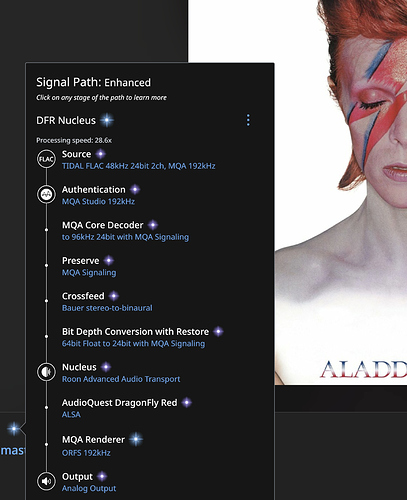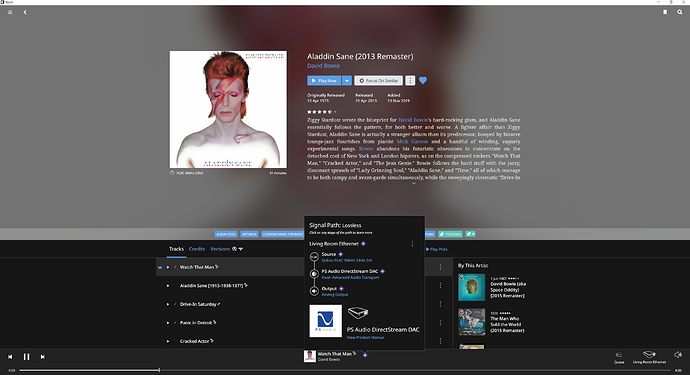I have my Nucleus connected via Ethernet, and my MHDT Orchid counted to the Nucleus via USB. Sounds amazing.
Hmm, as always, honored to play a part (however small) in an example of what one should not believe. 
Hmmm. USB Audio does in fact include device queries and device interrupts which can provide this level of feedback. And many sophisticated devices, like the Mytek line of DACs, provide additional non-USB-Audio USB interfaces (over a single cable) which allow for full control and monitoring of the DAC. I think it’s more likely to be an attempt to turn an MxN complexity problem into an M+N problem via the RAAT standard protocol.
I have been reading about this for the couple of years I have been doing digital audio. At present, I have a Nucleus + connected via ethernet to an isolated network and to the house router for connection to Tidal and uploading files I purchase on my desktop.
The Nucleus + is connected via USB to my Hugo TT2 and from there via XLR to my pre amp.
There is no ethernet connector on the TT2 so I think the USB is the best that I can to. What am I missing?
I wouldn’t worry about it unless you are hearing artifacts.
I appreciate that. I am confused still about how I would connect the Hugo TT2 to anything via ethernet. I wanted to understand what I am missing. It seemed to me that people were claiming this could be done. In terms of sound quality, I am pretty happy and am unlikely to change much. The system is my ‘final’ system. About the only thing I am likely to change is the addition of a vinyl portion of the system simply because there is material I can get there that I can not get in high res file formats.
Ah, sorry. Well, you’d need to add a streamer. A simple Raspberry Pi running RoPieee would work fine with the TT2, which is a great (if overpriced) DAC. You’d connect the Ethernet to the Pi, then USB into the TT2.
@richard_a I use a PS Audio DirectStream DAC with an optional ethernet card. It’s an excellent combination.
@Red_R I can’t think of any reason why this wouldn’t work. A USB DAC is a USB DAC. It shouldn’t matter if you are using the DragonFly or a Mytek Manhattan II.
Have fun!
Yes, a raspberry pi, or an ultraRendu, or a lumin, or a dcs network bridge, maaaan you can spend a ton of cash on streamers…or you can get a streamer with a DAC built in, or you can just connect your nucleus or innuos or whatever media server straight to your DAC. Methinks audiophile systems architecture is confusing, complex and leads to endless forum posts…oh damn
H
Thanks - does not seem like a win to me to add a streamer, but to each their own. If I were to go down that route, I would go with different vendors than I have now.
Well considering this is perhaps the very simplest way to listen to music using Roon, connecting a DragonFly directly to a Nucleus sounds pretty good. This solution may suffice… for a while at least.
@Red_R Here’s what my path looks like. I have multiple endpoints, mostly Sonore ultraRendu. In this case the path is:
Roon Rock --> Ubiquiti Unifi Switch --> Fiber uplink --> Ubiquiti Unifi Switch --> PS Audio Directstream DAC with Bridge II card.
And if that’s not convenient due to the location of your Nucleus and headphone location, an RPi4 running RoPieee or RoPieeeXL connected to your network using ethernet or WIFI is a great solution for a USB connected DAC.
What Is an RPi4 running RoPieee?
What is the purpose of this.
I am planning to connect a chord tt2 dac to a roon nucleus via usb, and then connect the tt2 to analogue ports on the back of a preamp and then onward to an amp and speakers. What more do I need?
This is a Raspberry Pi 4 single board computer running a minimalist Linux distribution with preinstalled Roon Bridge software. As the Raspberry computer has both Ethernet and WiFi to connect to a local network, this may be by far the simplest and cheapest solution to setup a Roon streamer. You can connect a DAC to the Raspberry’s USB port, or you can use one of many available extension boards called ‘HATs’ to output the digital signal on S/PDIF, AES, etc.
You don’t need anything more. If you can and want to connect your DAC directly to a USB port of your Roon Core computer (Nucleus), just do so. Many Roon users connect a DAC directly to their Core computer, and most are happy with this solution.
You need nothing more. What you describe will work fine. Enjoy it!
FWIW, I went from using a Windows laptop as an endpoint streamer to using a Raspberry Pi 4 running RoPieee. In both cases outputting USB to a Wadia 122 DAC. Significant improvement in sound quality going to the Raspberry Pi.
Unfortunately this statement is not entirely true. Audio over USB uses the isochronous mode, which does not feature error correction. Only bulk (used by e.g. hard drives) and interrupt have that feature.

